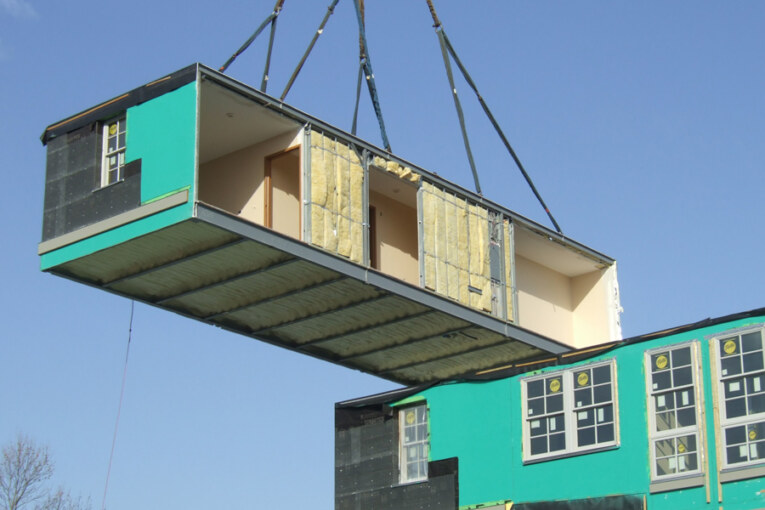
Introduction of Modular Construction
- Modular Construction is a pre-engineered process of making any structures or elementsin a factory that is off-site and are delivered to the sites and assembled as large volumetric components or as substantial elements of any structures.
- Modular coordination is a concept of coordination of dimension and space in which buildings and components are dimensioned and positioned in terms of basic unit or module.
- It can also be defined as “A modular building is a pre-engineered structure that is flexible enough to satisfy virtually any requirement tougher than standard drywall construction, expandable, can be relocated and completely re-usable.”
- With increasing industrialization to the building industry, steadily larger parts of buildings are made up of prefabricated components, delivered to the building site from the factories.
- Industrialized Building System can be defined as building systems in which structural components are manufactured in a factory, on or off site, transported and assembled into a structure with minimal additional site works.
- Industrialized Building System is one of the improved building systems that are being introduced to achieve the target of faster completion with mas s production of the building elements in places out of its final location in a building.
How Modular House differ from House built on site?
- Modular homes are built indoors, they can be completed in a matter of a few weeks, as opposed to months.
- They don’t see the typical on-site delays caused predominantly by the weather.
- Modular homes must conform to specific rules, guidelines and building codes that often surpass those of traditional on-site homes.
Characteristics of Modular Construction
- Modern design and manufacturing methods involving information technology like usage of Computer Aided Design (CAD) and Computer Aided Manufacturing (CAM).
- Open building concept- permitting hybrid applications, and adaptable to standardization and Modular Construction.
- One of the major characteristics of Industrialized Building Construction is the Industrial production of components through prefabrication, “OR” sometimes highly mechanized in-situ processes i.e. permanent steel formworks, tunnel forms, etc.
- Reduced labor during prefabrication of components and site works.
Why Modular Construction
- It provides a practicle and coherent: method for coordinating- the position and dimension of elements, components and spaces in the planning and design of buildings.
- One of the major reason to adopt modular construction is that not only can one save up to 35% on the initial construction costs like labor and materials, but there are other benefits as well.
- Another major reason is about the quality as one can attain a suitable quality in the elements of any structures of any structures that are to be pre-fabricated or pre-cast in the construction factory.
- Sustainability in modular construction can be achieved through the factory production of the modular units.
- For a modular construction project to complete with a good result, proper planning, coordination and communication must exist between various relevant parties involved from the early stage of the project.
- For mass production of building components in factories which ensure good and consistent workmanship and quality.
- To permit standarization, which encourages the use of standardized building components for the construction of different type of building.
- To provide guidance to building component sizing which can reduce the need to further trim and shape the materials to fit together in construction, hence, reducing wastage of labor and material.
Aims of Modular Construction
- To achiever compatibility between building dimensions, span or spaces and the sizes of components or equipment by using related modular dimensions.
- Making the planning simpler & clearer by distinct indication of location of the building component in the building, both in respect to each other & a modular grid.
- Simplification of site work.
- Limiting the member of sizes of building component so that the linkage is based on modular measurement.
- Facilitating cooperation between designers, manufactures, suppliers & builders.
Construction Process of Modular Construction
- Odular components are typically constructed indoors on assembly lines.
- The ntire process of modular construction places significance on the design stage.
- This is where practices such as design for manufacture and assembly are used to ensure that assembly tolerances and controlled throughout manufacture and assembly on site.
- The use of advanced CAD systems, 3D printing and manufacturing control systems are important for modular construction to be successful. This is quite unlike on-site construction where the tradesman can often make the part to suit any particular installation.
- Modules construction may take as little as ten days but more often one to three months.
Classifictaion of modules in Modular Construction
- Basic Module: It is the fundamental unit of size in modular coordination and for general application to building & components. The size of basic module is taken as 100mm denoted by ‘M’.
- Multi Module: Certain whole multiples of basic module usually expressed in as ‘M’ with prefix as 2M, 3M, 4M etc arereferred to as multi module.
- Sub Module: Certain submultiples of basic module which are whole simple fractions shall be chosen absolutely necessary for an increment smaller than the basic module.
Advantages of Modular Construction
- Reduction of site labor
- Cleaner environment
- Faster project completion
- Less site material
- Minimal wastage
- Neater and Safer site
- Lower total construction cost
Drawbacks of Modular Construction
- Limited customization
- Limited service area
- Payment Plans


